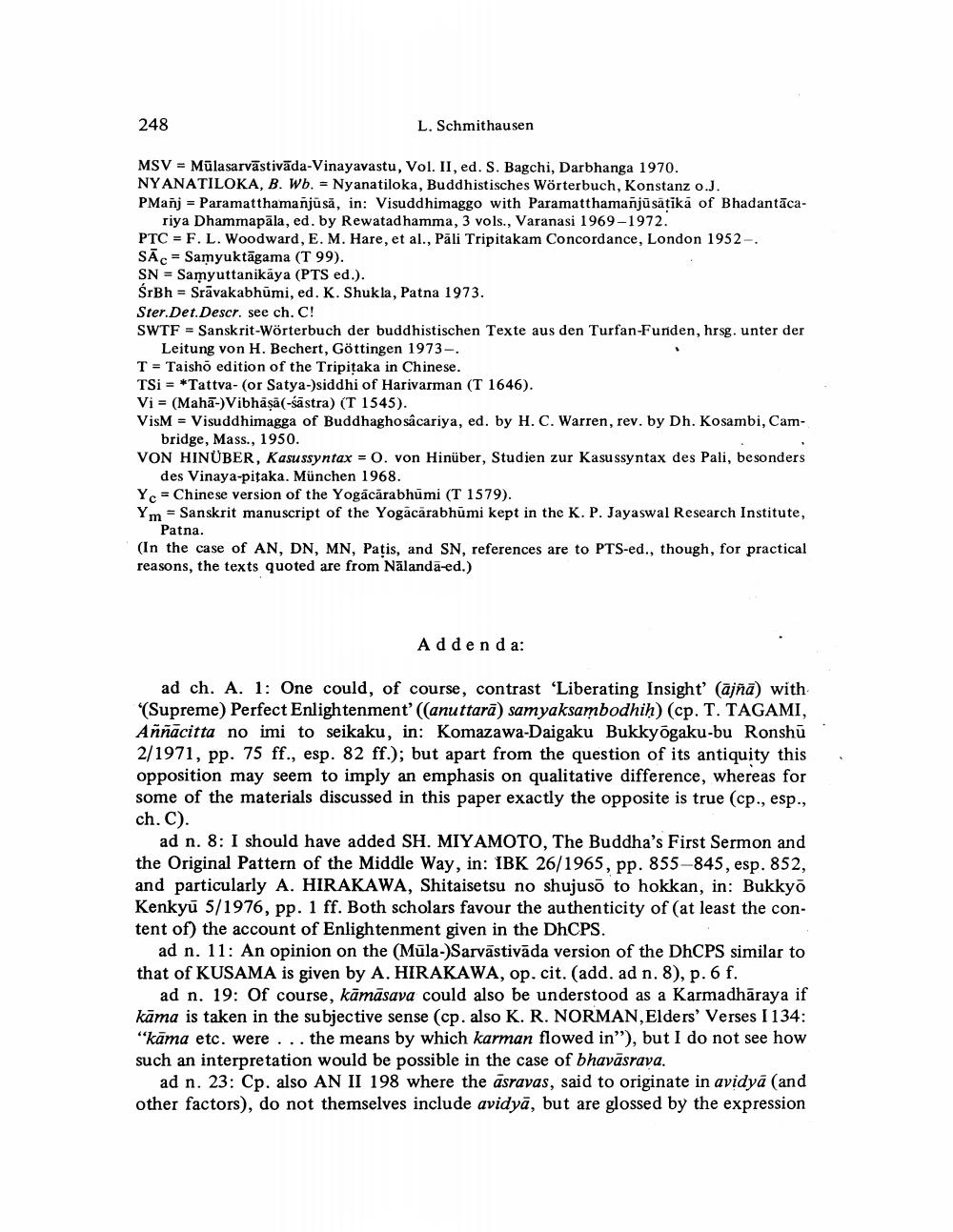________________
248
L. Schmithausen
MSV = Mūlasarvāstivāda-Vinayavastu, Vol. II, ed. S. Bagchi, Darbhanga 1970. NYANATILOKA, B. Wb. = Nyanatiloka, Buddhistisches Wörterbuch, Konstanz o.J. PManj = Paramatthamanjūsă, in: Visuddhimaggo with Paramatthamanjūsātikā of Bhadantāca
riya Dhammapāla, ed. by Rewatadhamma, 3 vols., Varanasi 1969-1972. PTC = F. L. Woodward, E.M. Hare, et al., Pāli Tripitakam Concordance, London 1952-. SĀC = Samyuktāgama (T 99). SN = Samyuttanikaya (PTS ed.). SrBh = Srāvakabhūmi, ed. K. Shukla, Patna 1973. Ster.Det.Descr. see ch. C! SWTF = Sanskrit-Wörterbuch der buddhistischen Texte aus den Turfan-Funden, hrsg. unter der
Leitung von H. Bechert, Göttingen 1973T = Taisho edition of the Tripitaka in Chinese. TSi = *Tattva- (or Satya-)siddhi of Harivarman (T 1646). Vi = (Mahā-)Vibhāsā(-sastra) (T 1545). VisM = Visuddhimagga of Buddhagho sácariya, ed. by H. C. Warren, rev. by Dh. Kosambi, Cam
bridge, Mass., 1950. VON HINÜBER, Kasussyntax = 0. von Hinüber, Studien zur Kasussyntax des Pali, besonders
des Vinaya-pitaka. München 1968. Y c = Chinese version of the Yogacărabhumi (T 1579). Ym = Sanskrit manuscript of the Yogācārabhūmi kept in the K. P. Jayaswal Research Institute,
Patna. (In the case of AN, DN, MN, Patis, and SN, references are to PTS-ed., though, for practical reasons, the texts quoted are from Nalanda-ed.)
Addenda:
ad ch. A. 1: One could, of course, contrast 'Liberating Insight' (ajñā) with (Supreme) Perfect Enlightenment' (anuttarā) samyaksambodhiḥ) (cp. T. TAGAMI, Aññācitta no imi to seikaku, in: Komazawa-Daigaku Bukkyôgaku-bu Ronshū 2/1971, pp. 75 ff., esp. 82 ff.); but apart from the question of its antiquity this opposition may seem to imply an emphasis on qualitative difference, whereas for some of the materials discussed in this paper exactly the opposite is true (cp., esp., ch. C).
ad n. 8: I should have added SH. MIYAMOTO, The Buddha's First Sermon and the Original Pattern of the Middle Way, in: IBK 26/1965, pp. 855-845, esp. 852, and particularly A. HIRAKAWA, Shitaisetsu no shujuső to hokkan, in: Bukkyo Kenkyū 5/1976, pp. 1 ff. Both scholars favour the authenticity of (at least the content of) the account of Enlightenment given in the DhCPS.
ad n. 11: An opinion on the (Mūla)Sarvāstivāda version of the DhCPS similar to that of KUSAMA is given by A. HIRAKAWA, op. cit. (add. ad n. 8), p. 6 f.
ad n. 19: Of course, kāmāsava could also be understood as a Karmadhāraya if kama is taken in the subjective sense (cp. also K. R. NORMAN,Elders' Verses I 134: "kāma etc. were ... the means by which karman flowed in"), but I do not see how such an interpretation would be possible in the case of bhavāsrava.
ad n. 23: Cp. also AN II 198 where the asravas, said to originate in avidyā (and other factors), do not themselves include avidyā, but are glossed by the expression




